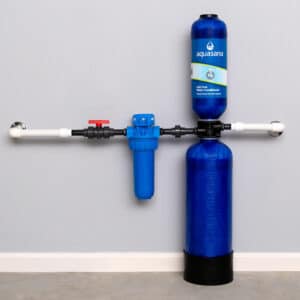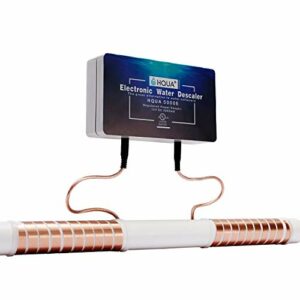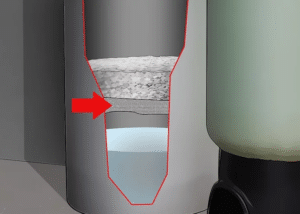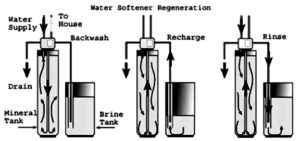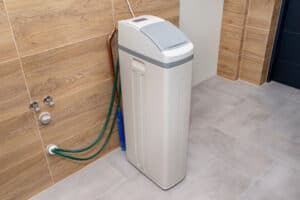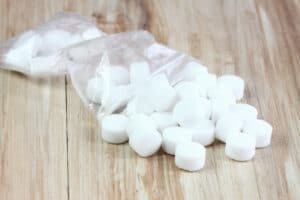Is your water softener not working as well as it used to? A quality water softener can perform optimally for 20 years, but it will need routine maintenance. You can minimize the care your water softener needs by using a quality resin.
Water softening resins are worth the investment. They soften the water by removing calcium and magnesium ions from the water. Without resin, your water softener won’t remove these ions, resulting in hard water.
Most resins will last for ten years before needing replacement, and some can last for the life of your water softener. Not all resins are equal, so it’s best to do some research before spending your money.
5 Best Water Softener Resin
1. Purolite C100E
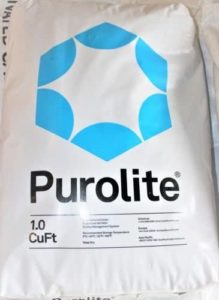
The resin has a lifespan between 10 and 15 years, reducing the amount of maintenance you need to do. It also reduces the amount of money you spend on salt. Your water softening system works more efficiently, resulting in lower utility bills.
Using shallow shell technology, the resin shortens the ion exchange process. You get soft water faster and use salt more efficiently. Depending on your system and water quality, you can reduce your salt usage by up to 1,400 pounds per cubic foot annually.
- Affordable price
- Efficient at softening water
- Minimizes the risk of leaks in your pipes
- May not be able to remove high iron levels from the water.
2. Aquatrol Water Softener Resin
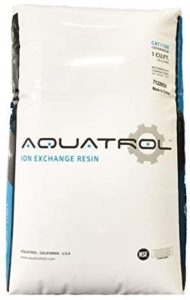
The high-capacity resin doesn’t break down in cold or hot water. It’s also not affected by high alkalinity levels, thanks to its 95% bead count. The whole beads help ensure your water softener is working at a peak flow rate while reducing backwash.
What set’s this resin apart is how easy it is to use. The bag has a handy pour spout making it easy to get the right amount into the water softener. It’s ideal for tanks measuring 9” x 48”, which is standard for most residential buildings.
- Long-lasting up to 15 years
- FDA approved for residential use
- Doesn’t breakdown in hot or cold water
- Not designed for commercial or industrial use
3. Tier 1 Ion Exchange Resin
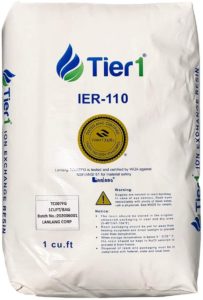
It is easy to apply to your system and starts working immediately to remove soap scum and lime-scale deposits. Your plumbing and appliances will last longer, and you’ll see an improvement in their performance.
This resin lasts for 10 years. It’s not as long-lasting as some others, but it is standard for strong acid sodium cation products.
- Easy to use
- Money-back guarantee
- Starts cleaning and softening the water on contact
- Bags sizes are smaller than other brands
4. Liquagen Water Softener Resin with Funnel
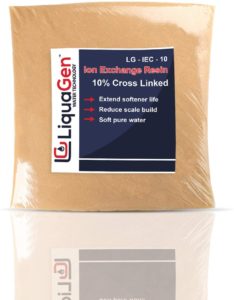
With a 10% crosslink, this resin can last for over ten years. You spend less time on maintenance while still enjoying soft, mineral-free water. If your water is high in iron or chlorine, you need a resin with a high crosslink.
Its ion exchange process removes minerals from the water, and you won’t have to worry about the beads breaking down. They have thermal and chemical stability and can soften water with high alkaline levels.
The resin comes in 2 cubic foot bags, ideal for most residential use.
- High crosslink
- Easy to use with the included funnel
- Large bag size
- The bag and funnel are shipped separately.
5. AFWFilters High Capacity Resin
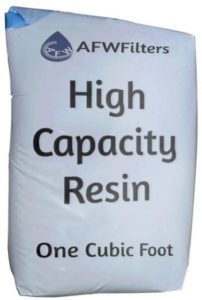
The resin beads are made from polystyrene sulfonate cation and are intended for use in both home and commercial buildings. It effectively removes minerals from the water, and the FDA approves the resin beads.
You can find this high-capacity resin in varying sizes. If your water softener tank is 9” x 48”, a one cubic foot bag will work great. With a grain of 32,000, you won’t have to worry about hard water and limescale build-up again.
- Long-lasting up to 15 years
- Budget-friendly price
- Removes minerals and scale from the water
- The resin beads are not strong enough for high levels of chlorine or iron.
Why Use Resin?
Anyone with a saltwater softener tank needs to use resin to remove the minerals. It is the only way to get soft water.
The resin is where the ions are exchanged. The resin exchanges its sodium ions for the magnesium and calcium found in the hard water.
Having hard water may not seem like a big deal until you start repairing and replacing your appliances. The minerals in hard water are hard on appliances and plumbing.
How Water Softening Resins Work
Water softening resins use the most common softening method – Ionization. They use sodium to remove the minerals and soften water.
- The resin beads in the tank attract hard water ions.
- To keep balance in the water, the resin releases sodium ions. These are the positively charged ions that attract the negatively charged ones in the hard water.
- When the resin beads are saturated with negative ions, the water softening system is cleansed. Saltwater from the brine tank is flushed into the softening tank, washing away the negative ions, allowing the resin to recharge and release more sodium ions.
- After the magnesium and calcium ions are flushed, the system restarts, softening your water.
This cycle continues until the resin reaches the end of its lifespan, usually after 10 to 15 years.
When To Replace Your Water Softening Resin
Unfortunately, your water softening tank doesn’t come with an alert indicating when it’s time to change your resin. It’s something you have to pay attention to and follow the manufacturer’s recommendations.
A good tip is to familiarize yourself with your local water quality. It affects the resin’s lifespan. It is not uncommon for some neighborhoods to have a high chlorine content. Others may have elevated levels of iron. These minerals and others can shorten how long the resin is viable.
Some signs your water isn’t soft are hard water stains on dishes and glass shower doors. You may also notice lime buildups in sinks and toilets. If your soap isn’t as foamy as it used to be, it may indicate it’s time for a water softener resin replacement.
What Causes Resin to Become Ineffective
Some issues in your home’s plumbing may cause the resin beads to break down early. The quality of the water source and the amount of wear and tear you put on your water softener are the deciding factors. Here are some of the things that can cause you to replace your resin more often.
Water Hammering
Watering hammering is named for the knocking sound you hear in the pipes when water abruptly shuts off. Besides the hammering sound, the resulting shockwave also degrades the resin beads. Water is forced rapidly into the tank, hitting the beads with tremendous force.
It’s a problem for even the best-rated resin.
High Chlorine Levels
A DVB (Divinylbenzene) agent holds the resin beads together. Think of it as the glue holding everything together. When exposed to high concentrations of chlorine, the glue begins to lose some of its binding agents. When this happens, parts of the beads are flushed through the water system. The remaining beads will have a more challenging time performing the ion exchange resin.
Gradually, your water will start turning harder.
High Iron Levels
When you first pour the resin beads into the water softener tank, they won’t have a problem holding all of the negative ions. However, if your water is high in iron, the resin beads will not last as long.
Iron ions take up a lot of space in resin beads. If your water has a lot of iron, the beads will have little room for magnesium and calcium ions. While the resin will still soften the water, the system will not function as efficiently.
You can optimize your water softening system by using a fine mesh resin.
Osmotic Shock
Resin beads can start expanding and contracting. It usually happens to old or inferior beads. The beads change sizes as they are catching and releasing minerals. Over time, it will cause them to break down.
You won’t notice bits of the beads in your water supply, but you will see the spots left behind on glass.
Lower Amounts of Resin
Osmotic shock and water hammering are the two leading causes of reduced resin in your water softening tank. Another reason is the system not having enough to begin with.
When pieces of resin are flushed away during the cycle regeneration, you lose ion exchange effectiveness.
Your water may not be as soft as it used to be.
What is Crosslink and Does Percentage Matter?
Your water softener resin bead consists of polystyrene strands that are crossed over each other. Each point the strands cross over each other or intersect is known as a crosslink.
The number of crosslinks is what determines the resin bead’s percentage rating.
You want to look for resin beads with a high crosslink. The higher the percentage, the stronger the resin is. Most household and commercial water softening resins come in two percentage strengths,
- 8% crosslink resin
- 10% crosslink resin
Most older resins have an 8% crosslink. It is the most common sold in stores and online, but this is changing as 10% crosslink resin becomes more readily available.
Upgrading to a 10% crosslink resin makes sense if your water has a high chlorine level. Chlorine gradually weakens the polystyrene brands causing the resin to lose strength. You need a higher percentage resin unless frequent replacements aren’t a problem.
If you aren’t sure what the chlorine content is in your water. You can find home kits at most home improvement stores and online.
One exception is homes using well water. The chlorine content is lower, and it may not be necessary to switch to a 10% crosslink resin.
Types of Resin
Resin doesn’t only come with different percentages, but also in two types, fine mesh and ion exchange. Each kind of resin has its best uses, depending on your water supply.
Fine Mesh
If you have well water (also known as ground water), consider getting fine mesh resin. It is designed to remove the iron ions commonly found in well water. With standard ion exchange resin, you need to add a filter to trap excess iron particles. It’s not necessary with fine mesh resin.
Fine resin is packed more tightly together than standard water softener beads. The smaller beads have a large surface area, ideal for trapping iron ions.
Most fine mesh resin softeners can filter out 5 parts per million (ppm) of iron particles from the water. Some can remove up to 10 ppm.
Some fine mesh resins also remove hydrogen sulfate and iron from the water. Others remove sulfur from the water, improving its smell and taste.
If your water smells like rotten eggs, look for a fine mesh resin that also removes sulfur.
The Disadvantage of Fine Mesh Resin
Fine mesh resin has a downside. The thick woven strands work great at removing iron ions from well water, but it also interferes with water flow. You may notice your water running slower with fine mesh resin. It is why ion exchange resin is commonly used in buildings with municipal water.
Ion Exchange Resin
Anyone with municipal water is probably using ion exchange resin. The standard or cation style resin switches out positive ions for the negative ones in your water.
Ion Exchange resin removes up to 5 ppm of soluble iron from hard water, but it does have trouble eliminating insoluble iron. If your water isn’t as soft as you want, then you should test its iron content. You may need to add a filter or switch to a different type of resin.
The premise of this resin is simple: It exchanges positive ions for negative ones, eventually flushing them away. Ion exchange resin efficiently removes magnesium and calcium commonly found in municipal water.
What to Consider Before Buy Water Softening Resin
It’s easy to grab the first bag of resin you see in the store or online. You may get lucky and find you got the right one for your water softening tank. There’s an easier way. You can find out what to look for in a water softening resin.
Type of Resin
Your water source determines what type of resin is best. If your plumbing is supplied by well water, you want to use fine mesh resin. It also applies to municipal water with high iron content. If chlorine and magnesium are your problems, use ion exchange resin.
The type of resin you use ultimately comes down to what minerals are in your water.
Resin Lifespan
Some homeowners are fortunate enough to have water with low mineral contents. In this case, the resin can last up to twenty years if it is of high quality.
Most water supplied to homes and commercial buildings have iron and chlorine ions which can cause the resin to degrade faster.
When there are around 1.0 parts per million of chlorine in the water, the resin will work effectively for about ten years. Adding a chlorine filter to the water softener tank will increase the resin’s lifespan, but it is an added expense – this filter needs to be changed relatively often compared to resin.
Crosslink Percentage
The resin’s crosslink percentage depends on the iron levels in your water and how long you expect it to last.
The higher the percentage, the more durable the resin. Almost every homeowner wants to use a 10% crosslink resin in their tanks. It may reduce water flow a bit, but you will spend less time replacing the resin beads.
Homeowners with well water can usually safely use 8% resin beads if the iron levels are low in their water supply.
Ease of Use
It doesn’t seem like resin beads are hard to use. Just pour them into the tank. It is the goal, but it is a little harder to achieve with some brands of water softening resins.
To make it easy, and prevent spillage, look for resin bags with pour spouts or funnels. It gives you more control over where the beads go.
How your tank is designed will also determine how easy it is to pour the resin in. It is easier to use fine mesh resin in well water softeners than municipal ones with ion-exchanged beads.
FAQs About Water Softening Resin Beads
It’s not uncommon to have questions about water softeners and resin beads. After all, no one wants to deal with hard water and the film it leaves behind.
If all you want is to stop hard water stains, a saltless water softener bead will do the trick. You won’t have to worry about limescale around drains and faucets. It makes cleaning faster and easier.
The downside is salt-free resin does not soften your water. Salt-based resins only remove the negative ions that cause hard water.
Water consumption rates will affect how long the resin is effective in the tank. The more water you use, the harder the beads have to work.
More significant water usage means the beads are flushing more frequently. It adds to the wear and tear they go through under normal ionization.
Decreasing your water usage is good for the environment. You can also use a higher percentage resin bead. It will last longer under frequent use.
Anyone using a salt-based water softening tank should know that the salt needs to be replaced every three months. While it may last longer depending on your usage, you will undoubtedly replace the salt more often than the resin. Most resins last for at least ten years.

